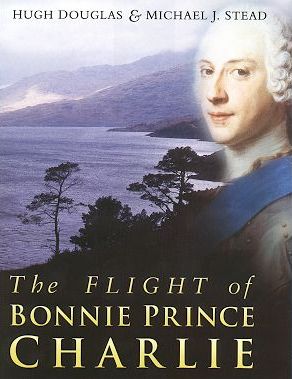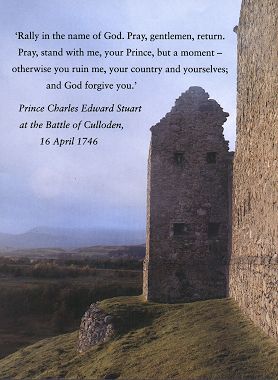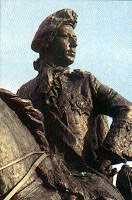 |
 |
| Front Cover | Back Cover |
Inside Cover
On
22 July 1745 Prince Charles Edward Stuart, heir to the exiled Stuart dynasty,
made landfall at Barra Head, the southernmost tip of the Outer Hebrides. For the
25-year-old prince, it was a day he had waited for all his life, and an historic
moment, for it was the first time he had touched the soil of his native
Scotland. From childhood he had been brought up to believe that the Stuarts had
a divine right to rule Britain; now it lay within his grasp. But within nine
months, his plans lay in ruins at the feet of the Hanoverians. For six glorious
weeks, he had reigned at Holyroodhouse as Prince Regent, adored by every
Jacobite who had dreamed of a Stuart monarchy and  mesmerised
by sweet success; now the restoration was over. The flight of Bonnie Prince
Charlie, after defeat at Culloden brought the rising to a bloody end, was one of
history's great manhunts. For many historians Culloden is the end of the
Jacobite rising, but the dramatic story of the Prince's flight during five
rain-soaked months of a Highland summer of 1746, when he was hunted down
ruthlessly by King George II's men, reveals not only the reality of the loss of
a young prince's hopes and brave ambitions, but the desperate nature of the
struggle between the Jacobites and Hanoverian Britain. It tells of great courage
and endurance, of bravery, and the loyalty of Highland followers, who guarded
him faithfully, rejecting the £30,000 reward King George offered for his
capture. They spirited him from mainland hideouts to the far Hebridean isles and
back again, fed him, clothed him, and hid him in their homes and in caves in the
mountains. Finally they brought him back to Loch nan Uamh, the remote sea loch
where the 'rash adventure' of the '45 Rising had begun, to escape to France. It
was a journey which created one of Scotland's most treasured legends.
mesmerised
by sweet success; now the restoration was over. The flight of Bonnie Prince
Charlie, after defeat at Culloden brought the rising to a bloody end, was one of
history's great manhunts. For many historians Culloden is the end of the
Jacobite rising, but the dramatic story of the Prince's flight during five
rain-soaked months of a Highland summer of 1746, when he was hunted down
ruthlessly by King George II's men, reveals not only the reality of the loss of
a young prince's hopes and brave ambitions, but the desperate nature of the
struggle between the Jacobites and Hanoverian Britain. It tells of great courage
and endurance, of bravery, and the loyalty of Highland followers, who guarded
him faithfully, rejecting the £30,000 reward King George offered for his
capture. They spirited him from mainland hideouts to the far Hebridean isles and
back again, fed him, clothed him, and hid him in their homes and in caves in the
mountains. Finally they brought him back to Loch nan Uamh, the remote sea loch
where the 'rash adventure' of the '45 Rising had begun, to escape to France. It
was a journey which created one of Scotland's most treasured legends.
As well as the charismatic prince himself, the characters of his chief supporters and opponents are brought vividly to life: Flora MacDonald, who smuggled the Prince to Skye disguised as her maid, Betty Burke; Neil MacEachain; the Duke of Cumberland, whose relentless pursuit of the prince became an obsession. Alongside the story of the Prince's flight, thematic panels depict particular aspects of the Stuart story: Culloden, the last battle to be fought on British soil; Clan Donald and Prince Charlie; Flora MacDonald; France and the '45; The Royal House of Stewart. With its magnificent colour photographs showing the dramatic locations of Bonnie Prince Charlie's months 'on the wing', and strongly told narrative, this book will appeal not only to anyone fascinated by the tragedy and triumph of the Stuart cause and its place in British history, but also to visitors to the landscapes which the Prince made his own.
HUGH DOUGLAS is the author of fourteen books, including biographies of Charles Edward Stuart, Robert Burns and Flora MacDonald. He was born near Ayr, in southwest Scotland, and spends his time travelling in and writing about Scotland and Scottish history - his first love. His latest book, Jacobite Spy Wars: Moles, Rogues and Treachery, was published by Sutton in 1999.
MICHAEL J. STEAD has gained a reputation as one of Britain's leading landscape photographers. His previous fourteen books include In the Footsteps of Robert Bruce (Sutton, 1999; with Alan Young), King Arthur's Britain: A Photographic Odyssey (Blandford/Cassell 1995), and English Villages (Headline, 1992; with John Timpson). As photographer/author he has produced Queen Victoria's Scotland (Cassell, 1992) and Literary Landscapes (Lennard, 1989).